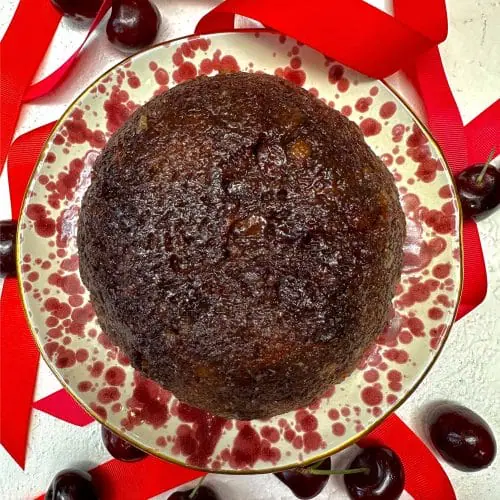
Sago Christmas Pudding
The notion of dietary-friendly cooking may be relatively new, but leaning on old ideas borne out of austerity is one way to make their bare necessities our own. Sago has actually been used in puddings like this from the turn of the 19th century as a way of lightening a dense Northern Hem dish into something suitable for an Australian summer. It gained particular popularity during The Great Depression and World Wars as a way of binding desserts without the need for egg. I’ve popped an egg into this one as it does add a lovely richness and gloss, but if you have the added complexity of egg allergies in the mix, then upping the sago to a quarter cup should do it. You’ll need to start the recipe the night before as the sago needs time to ‘bloom’, but if you’re in a hurry, heat the milk to just before the boil and pour it over the sago, then give it as long as you’ve got to wait for it all to stop steaming and sago to become gelatinous before continuing with the steaming bits. I based this one on my friend’s Aunt Sandy’s recipe, and she only gave it up when I promised attribution - so thank you, Sandy, for the inspiration! I’ve taken it further by adding carrot to the original recipe, so it’s a bit more moist, and a bit more modern - like a carrot cake sago pudding, that’s gluten-free AND dairy-free. For dairy-free spread, we used Nutellex, and for non-dairy milk, it’s been tested with everything from soy to almond milk with great success. It’ll keep well in the fridge, so you can make this days - or even weeks in advance, and re-steam for around 45-60 minutes before serving with brandy butter.
PRINT
Ingredients
- 2 tbsp sago or tapioca pearls
- 1 cup non-dairy milk such as almond or soy
- 2 tsp bicarb soda
- ½ tsp salt flakes
- 2 tbsp non-dairy spread plus extra for greasing
- 1 egg
- 1 ½ cup 100g soft breadcrumbs can use gluten-free white bread
- 1 cup 170g sultanas
- ½ cup 80g raisins
- ¼ cup 50g mixed peel
- ¾ cup 150g brown sugar
- 1 small carrot (70-80g) coarsely grated
- 1 tsp each of mixed spice and cinnamon
- Zest of 1 orange
Instructions
- In a lidded bowl or other container pop the sago, milk and bicarb to soak overnight, either in the fridge or on the bench-top. You want the sago to have at least 10 hours for soaking.
- Grease and line the basin of a 1L ceramic pudding bowl or non-stick pudding steamer bowl.
- In a medium mixing bowl, beat the egg, then pour in the milk mixture. Tumble in the rest of the ingredients, stirring with a wooden spoon or flexible spatula to a sloppy consistency (it’s supposed to be sloppy - have faith!)
- Pour the batter into the greased pudding basin. If using a ceramic bowl, make a ‘lid’ with a 25cm piece of baking paper then a piece of foil bigger than the baking paper. Lay on top of each other and place baking paper side down over the top of the pudding bowl edge. Push down around the edges to seal your ‘lid’, you will have lots of overhang, which is good. Grab some string and wrap the lip of the bowl to secure the paper. This ‘lid’ helps with the steaming and also helps keep too much water from getting in.
- Once the string is tied, cut away any excess baking paper and then scrunch up the foil to wrap around the top edge of the bowl.
- Grab a large shallow pot that will hold your pudding bowl securely, allowing easy access for release. Put a folded tea towel on the bottom the pot, and pour in enough water so that it’s half-way up the pudding basin. Bring to a boil, then drop down to a gentle simmer, popping on a timer for 2.5 hours. When the timer goes off, switch off the heat, let it sit for 5 minutes in the water and then remove and let it set and cool on the bench. Once cooled, pop into the fridge until needed.
- Steam for at least 45 minutes to reheat, or leave it cold if it’s a very hot Christmas day.
- Serve with brandy butter, coconut cream, non-dairy ice-cream or whatever you’d like!